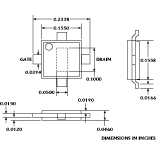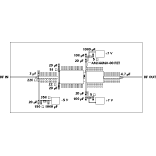A LOW NOISE FREQUENCY SYNTHESIZER FOR THE CELLULAR BAND
Program Test Sources
Littleton, MA
 In mixed-signal automatic test equipment systems, which cost from $1 M to $2 M, broad coverage from 1 to 1000 MHz or even 1 to 3200 MHz is not a luxury since the system is then armed for most any demand. Prices for broadband generators are not burdensome in these general-purpose high end systems. In contrast, a new special-purpose frequency generator has been developed that covers the range from 800 to 960 MHz with 0.1 Hz resolution, features low noise and jitter, and switches frequency within 3 to 20 ms. The model W-800 slot synthesizer covers several of the cellular/personal communications service bands. With the specialization of the market, a significant growth in middle-ground special systems is occurring. The 800 to 960 MHz limitation in coverage has enabled a particularly cost-effective synthesizer solution to be developed.
In mixed-signal automatic test equipment systems, which cost from $1 M to $2 M, broad coverage from 1 to 1000 MHz or even 1 to 3200 MHz is not a luxury since the system is then armed for most any demand. Prices for broadband generators are not burdensome in these general-purpose high end systems. In contrast, a new special-purpose frequency generator has been developed that covers the range from 800 to 960 MHz with 0.1 Hz resolution, features low noise and jitter, and switches frequency within 3 to 20 ms. The model W-800 slot synthesizer covers several of the cellular/personal communications service bands. With the specialization of the market, a significant growth in middle-ground special systems is occurring. The 800 to 960 MHz limitation in coverage has enabled a particularly cost-effective synthesizer solution to be developed.
The generator's frequency synthesis process is based on an internal or external 5 or 10 MHz crystal oscillator. In terms of jitter, short-term stability or phase noise, the model W-800 produces good performance when using the company's high stability 10 MHz oscillator. This performance is also obtained when high quality external sources are used. Figure 1 shows the frequency synthesizer's typical single-sideband phase noise from 10 Hz to 10 MHz from the carrier. Direct digital synthesis (DDS) is used to produce fine resolution. The 2 MHz coverage with 0.1 Hz steps and provision for phase programmability produces spurious levels of -65 dB, a level mandatory for mixed-signal testing as well as clock purity requirements. DDS has been covered extensively in the literature and is a mature technology. The DDS process used in the W-800 synthesizer is a hybrid binary-coded decimal (BCD) to produce exact decimal steps from the normal 5 or 10 MHz standard oscillator.
In the synthesizer circuitry, 2 MHz steps are introduced with upconversion, resulting in a 10 MHz cumulative coverage. Two mixers with associated filters and RF switches produce a 140 to 150 MHz output band. An auxiliary frequency module contributes five frequencies from 14 to 22 (n ´ 2) and 100 MHz to the process.
 The auxiliary frequency module produces all the fixed frequencies needed in the synthesizer from a single 10 MHz pulse containing all harmonics up to 170 MHz. Frequencies of 14 to 22 (n ´ 2) are produced by dividing 70 to 110 MHz by 5. Close attention is paid in all operations to maintain the purity (low phase noise) of the frequency standard. The 140 to 150 MHz frequency is input to the 10 MHz step generator. A narrowband filter is used to suppress neighboring ±10 MHz pickets. The technique employed is similar to the superheterodyne configuration in principle, with tunable selectivity replaced with a stable fixed-tuned filter. At the same time, the 10 MHz step generator section performs upconversion to final mix frequencies, which are high enough to produce a ±80 MHz band centered around 200 MHz with moderately low spurious content. The following module is required to upconvert the 160 MHz band to produce 680 MHz. The auxiliary frequency module's 10 MHz pulse is filtered in this module to yield a clean 170 MHz line, which, after multiplication by 4 and additional filtering and amplification, supplies the high level input to the final mixer. The low level input is the 120 to 280 MHz mixer input and the upper sideband is the desired 800 to 960 MHz signal.
The auxiliary frequency module produces all the fixed frequencies needed in the synthesizer from a single 10 MHz pulse containing all harmonics up to 170 MHz. Frequencies of 14 to 22 (n ´ 2) are produced by dividing 70 to 110 MHz by 5. Close attention is paid in all operations to maintain the purity (low phase noise) of the frequency standard. The 140 to 150 MHz frequency is input to the 10 MHz step generator. A narrowband filter is used to suppress neighboring ±10 MHz pickets. The technique employed is similar to the superheterodyne configuration in principle, with tunable selectivity replaced with a stable fixed-tuned filter. At the same time, the 10 MHz step generator section performs upconversion to final mix frequencies, which are high enough to produce a ±80 MHz band centered around 200 MHz with moderately low spurious content. The following module is required to upconvert the 160 MHz band to produce 680 MHz. The auxiliary frequency module's 10 MHz pulse is filtered in this module to yield a clean 170 MHz line, which, after multiplication by 4 and additional filtering and amplification, supplies the high level input to the final mixer. The low level input is the 120 to 280 MHz mixer input and the upper sideband is the desired 800 to 960 MHz signal.
The remaining circuitry amplifies and amplitude levels the signal to produce a flat +13 dBm output. Because the mix ratio of the final mixer is not optimum (as it could be with much higher input frequencies), low order mixer products fall near the desired output. To retain a spurious level of -65 dB at ±10 MHz from the carrier at any output frequency, the output band was split and two bandpass filters of 800 to 880 MHz and 880 to 960 MHz are provided at the appropriate frequency and switched automatically. A simple highpass network attenuates unwanted lower frequencies further. Figure 2 shows a block diagram of the frequency synthesizer. Table 1 lists the synthesizer's key specifications. The W-800 synthesizer is available in a 19" ´ 3.5" ´ 18" rack or bench cabinet weighing 20 lb. The unit with remote control only (BCD parallel interface) is priced at $4800 without the optional internal frequency standard.
Programmed Test Sources Inc. (PTS)
Littleton, MA
(508) 486-3400.
